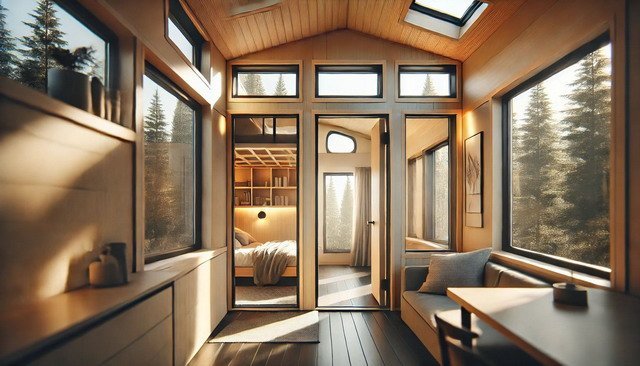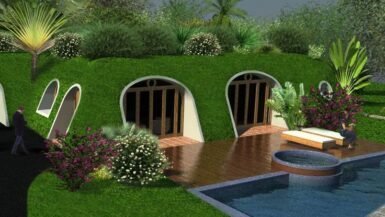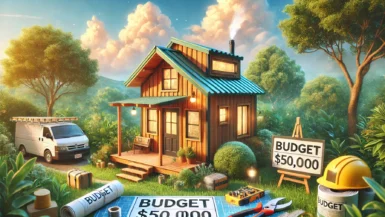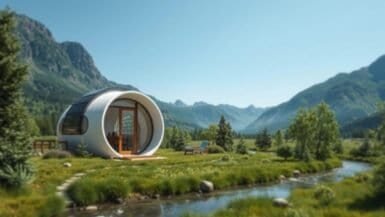Tiny houses are all about making the most of every inch, and that includes windows. These small homes may have limited space, but windows can transform how they feel, function, and flow. Whether you’re designing your own tiny house or just curious, the question of “How many windows should a tiny house have?” is worth a deep dive.
The right number of windows can mean the difference between a home that feels bright and airy versus one that feels cramped and closed off. Let’s explore what it takes to strike the perfect balance.
Why Windows Are Crucial for Tiny Houses
Windows do more than let in light—they bring life to your tiny house. Think about it: in a space where every square inch counts, your windows are working double duty. They serve practical purposes like ventilation and insulation, but they also define how your home looks and feels.
Natural Light Enhances Space
One of the biggest challenges in tiny house living is avoiding that claustrophobic feeling. Windows play a key role in visually expanding the space. When natural light pours in, it creates the illusion of a larger area, making your home feel welcoming and open. Even a well-placed skylight can make a massive difference in brightening up corners or loft spaces.
Ventilation for Comfort and Airflow
In compact spaces, good airflow is non-negotiable. Windows provide natural ventilation, helping to regulate the indoor temperature and keep the air fresh. This is especially important in areas like kitchens, where cooking can quickly heat things up, or in sleeping lofts, which can get stuffy.
Connection to Nature
One of the joys of tiny house living is the sense of freedom it offers. Windows allow you to stay connected to the outdoors, framing views of nature and bringing in a sense of calm. Whether it’s a panoramic window showcasing a mountain view or a small kitchen window looking out at a garden, windows remind you of the beauty outside.
Energy Efficiency Matters
Windows also play a vital role in energy efficiency. Strategically placed windows can reduce the need for artificial lighting during the day, saving energy. With the right design, windows can also support passive heating in winter or cooling in summer, making your tiny house both eco-friendly and comfortable.
Factors to Consider When Deciding on the Number of Windows
Determining the perfect number of windows isn’t a one-size-fits-all solution. It depends on your unique needs, preferences, and the design of your home. Here’s what you should consider:
Size of Your Tiny House
The overall size of your tiny house sets the stage for how many windows you’ll need. A smaller house might feel overwhelmed with too many windows, while a larger tiny house might need more to ensure even light distribution. For example, a 200-square-foot home might do well with 5-7 windows, but a 400-square-foot layout could comfortably accommodate 8-10.
Functionality of Each Space
Think about how each area of your tiny house will be used. In a living area, large windows can provide maximum illumination and a sense of openness. For the kitchen, smaller windows above counters or near the sink might be better suited to provide ventilation and natural light without sacrificing storage space. Meanwhile, the bathroom calls for frosted or cleverly placed windows to maintain privacy.
Orientation and Natural Light
The orientation of your tiny house is crucial when planning windows. If your house faces south, you can take advantage of sunlight throughout the day with larger windows on that side. East-facing windows are great for morning light, while west-facing windows bring in the sunset. This careful planning ensures your home feels well-lit and cozy all day long.
Privacy Needs
While windows let you connect with the outside, they can also leave you feeling exposed. Think about where you need privacy. In spaces like the bathroom or sleeping loft, you might opt for smaller, strategically placed windows. Frosted glass or high-positioned windows can offer light without compromising seclusion.
Energy Efficiency and Insulation
Too many windows, or ones that are poorly insulated, can lead to energy loss. You want windows that maintain the balance between providing light and keeping your home temperature-regulated. Double-glazed or energy-efficient windows are great investments to ensure your tiny house stays warm in the winter and cool in the summer.
Ideal Window Placement in a Tiny House
Window placement can make or break the functionality of your tiny house. Thoughtful positioning ensures your home is both beautiful and practical. Here are a few ideas to inspire your design:
Living Area
This is often the centerpiece of a tiny house. Large windows, or even a set of French doors with glass panels, can bring in plenty of natural light and offer stunning views if your house is parked in a scenic location. High windows can add light without taking up valuable wall space, perfect for shelving or décor.
Kitchen
In the kitchen, windows do double duty. Smaller ones placed above countertops or near the stove can provide ventilation and keep the area bright. A strategically placed window can also offer a charming view while you cook or wash dishes.
Bathroom
The bathroom is all about balance. Small, frosted, or high-placed windows maintain privacy while still letting in natural light. For ventilation, consider a small operable window above eye level.
Sleeping Loft
The loft often feels like a cozy retreat, and windows can make it even better. Skylights are a popular choice here, offering ventilation, natural light, and a chance to stargaze from bed. Side windows can also help improve airflow and provide cross-ventilation.
Common Mistakes to Avoid
While it’s easy to get excited about adding windows to your tiny house, it’s important to avoid some common design pitfalls. Here are a few mistakes that can negatively impact your space:
Too Many Windows for Your Space
In a tiny house, it’s easy to fall into the trap of thinking more windows will always make the space feel bigger. However, too many windows can overcrowd the walls and limit your ability to include functional features like shelves or storage. Each window occupies valuable wall space, so it’s crucial to think about how each one serves the overall design of the home.
Ignoring Insulation and Energy Efficiency
If your tiny house isn’t properly insulated, windows can become a weak point in your home’s energy efficiency. Large, single-glazed windows might look beautiful, but they could result in heat loss during the winter and unwanted heat gain in the summer. When designing your tiny house, choose windows that offer good insulation properties, like double-glazed options, to prevent energy inefficiency.
Poor Window Placement
Not all windows need to be placed equally. In a tiny house, you have to be strategic about where windows go. Poor placement can lead to a lack of privacy, inefficient use of light, or even unwanted heat loss. For example, placing a large window directly across from the door could compromise privacy, especially if your house is parked in a public area. Take time to assess each room’s needs and plan window placement accordingly.
Overlooking Privacy
A tiny house might not have the same level of privacy as a larger home, so it’s important to keep that in mind when planning windows. While you want natural light, you don’t want to sacrifice your comfort. For rooms like the bathroom or the sleeping loft, consider using smaller, higher windows or frosted glass to allow light in without leaving you exposed.
Underestimating the Importance of Ventilation
While windows are great for light, they also need to provide effective airflow. Tiny houses often have limited space for HVAC systems, so it’s crucial to have windows that can open and close easily. If your home isn’t designed with proper ventilation, it can lead to stuffiness, condensation, and even mold over time. Make sure each space has windows that help with air circulation and temperature control.
Examples of Window Configurations for Tiny Houses
There’s no single “perfect” number of windows for every tiny house. However, some configurations work better for different sizes and lifestyles. Here are a few examples to consider:
Minimalist Setup (3-5 Windows)
For a tiny house that emphasizes simplicity and minimalism, a setup with just a few windows can work wonders. For instance, you might choose two large windows in the living area to allow ample light, one window in the kitchen for ventilation, and a small bathroom window for privacy. This configuration keeps the walls free for shelving, storage, or other essential features, maintaining a clean and functional space.
Bright and Open Setup (8-10 Windows)
If you crave as much natural light as possible, a brighter and airier setup with more windows could be perfect. This configuration could include several windows in the living area, with one large window on the south-facing wall to capture sunlight throughout the day. You might also add multiple smaller windows in the kitchen, bathroom, and loft. While it uses more wall space for windows, this setup results in a warm, open, and light-filled tiny house.
Balanced Design (5-7 Windows)
For many tiny house dwellers, a balanced approach offers the best of both worlds. This design keeps things light and airy without overwhelming the space. Consider placing three windows in the living room, one in the kitchen, and one in the bathroom for privacy. A window in the loft adds to the natural light while keeping your sleeping space comfortable. This setup strikes a perfect balance between functionality, comfort, and energy efficiency.
Conclusion
When deciding how many windows your tiny house should have, it’s important to think about more than just aesthetics. Windows have a direct impact on your home’s functionality, natural light, privacy, ventilation, and overall energy efficiency. The key is finding the right balance—too few windows can make your tiny house feel dark and cramped, while too many can crowd your walls and reduce storage potential.
Consider the size and orientation of your tiny house, the function of each space, and your personal preferences when planning window placement. Don’t forget about insulation, ventilation, and privacy—these factors are just as important as how many windows you have. Ultimately, the number and type of windows you choose should support a comfortable, functional, and energy-efficient living environment.
Now that you have a solid understanding of how to approach window placement in your tiny house, it’s time to start planning! Whether you’re already in the design phase or just dreaming about your perfect tiny home, think about how windows can enhance your space. Do you have any favorite window configurations or design tips? Share your ideas in the comments below!
If you’re still unsure about your tiny house design, don’t hesitate to reach out to a professional designer or architect who specializes in small spaces. They can help you choose the perfect windows to match your needs and create a home that’s both beautiful and functional.
Stay tuned for more tips on tiny house living, space optimization, and energy efficiency!





Leave a reply